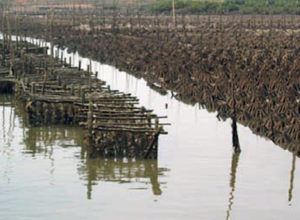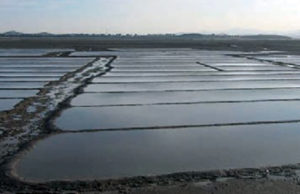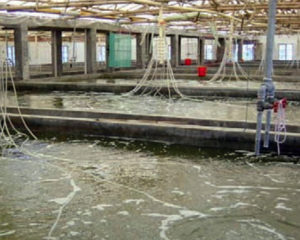Wild seed collection, production in earthen ponds and intensive hatchery production

Molluscan aquaculture in China has long been recognized as a low-investment, low-risk industry with the potential for high profits. Since the 1970s, mollusk farming has expanded rapidly beyond the traditional species of oysters, cockles, razor clams and Ruditapes clams. Disease outbreaks that affected the shrimp aquaculture industry in the past decade led to intensified efforts in molluscan culture.
Development of seed production and hatchery technology during the last 20 years helped molluscan culture become the largest sector of the Chinese mariculture industry. In 2000, China’s 8.6 million metric tons (MT) of molluscan aquaculture accounted for 81.1 percent of the total mariculture output.
At least 32 species of mollusks are cultured commercially in China via intertidal planting, floating rafts, and farming in earthen ponds. Seed methods include wild seed collection, production in earthen ponds, and sophisticated intensive hatchery production.
Wild seed collection
Wild seed collection is a traditional method with a long history in China. The collection areas are generally chosen near culture waters or coastal bays in which broodstock are abundant. The seeds of most benthic bivalves, such as razor clams (Sinonovacula constricta), Manila clams (Ruditapes philippinarum), meretrix clams (Meretrix meretrix), morella clams (Morella iridescens) and green clams (Cyclina sinensis) are collected from natural sources in farming areas.
Collection methods
Collection of natural seed requires understanding of the peak spawning and larvae attachment periods, and the distribution patterns of larvae. For wild oyster seed, collection sites should be selected in mid- to low tidal zones of closed bays with good current flow. Bamboo is usually used as a collector in soft mud substrates. Cement blocks, concrete stakes, and stone strips are used in mud-sand substrates, while shells and rocks are used in sand.
For Zhikong scallops (Chlamys farreri) collection sites are usually selected in farming areas with water depth of about 20 meters, over 4 meters of water transparency, and stable salinity around 32 ppt. Two kinds of collectors are commonly used. “Onion bags” consist of 300- x 450-mm plastic webbing with 1.2- to 1.5-mm mesh filled with 100-g plastic netting threads. Lantern nets, which are about 30 cm in diameter and 60-100 cm in height, have five or six layers with 20-g nylon threads in each layer.
Metamorphosis, attachment
When larvae reach about 185 to 195 µm in shell length, metamorphosis and attachment occur in three to five days. After a month or two, when the spat grow to 2 to 3 mm in shell length, the collectors are swung in the water to clean off sediment. Usually the seeds are harvested in mid-October.
The larvae above 10 mm in shell length are sold directly to farmers in southern China, and the smaller mollusks are maintained at nursery sites at 5 to 10 times grow-out density until the following March, when the juvenile scallops reach 2.0 to 3.0 cm.
Collection beds
Since the late 1970s, the complete protocol for wild razor clam seed collection has been well established. The key technique is construction of collection beds in mid- to high tidal zones that are completely submerged at high tide and completely exposed at low tide to enrich blooms of benthic diatoms for feeding the seed.
To build the beds, mud is dig up to create 20- to 30-cm banks with a 1-meter mouth. Herbicides or calcium oxide is sprinkled within the beds to get ride of injurious organisms. Drainage channels in each row of beds maintain exposure at low tide.
After five or six days of spawning or before several days of spat attachment, the beds are drained and raked smooth to prepare for spat settlement. About 45 days after spawning, when seeds grow to the size of 2 mm, farmers usually collect the seed using a special mesh net and transplant them to other plots for a nursery phase at lower density.
Earthen pond production
Earthen pond production is the main system for the culture of seed for shallow benthic bivalves including mud cockles (Tegillarca granosa), manila clams and green clams in China.
Construction
Earthen ponds are generally 0.5 to 2.0 ha in area and 1.5 to 2.0 meters in depth. Since good drainage is essential, construction first involves clearing silt and rocks for the pond bottoms. Then the pond bottoms are plowed and exposed to air for 10 days. After construction, the ponds are disinfected and treated with calcium oxide or herbal pesticides to remove unwanted organisms.
Water, algae control
In general, about two weeks before induced spawning, ponds are filled to a 50-cm depth with seawater filtered through 100-µm mesh screens. Urea, calcium phosphate, and sodium silicate fertilizers are applied every three to seven days to encourage blooms of natural microalgae. After several days, more filtered seawater is gradually added to reach an algae density of about 10,000 cells per millileter and keep water quality steady.
Larval rearing

Broodstock with well-developed gonads are induced to spawn in the ponds. A density of 1-4 D-shape larvae per millileter is desired. No water is discharged during larval rearing, but ponds are supplemented with fresh water to adjust water quality.
Most shallow benthic bivalve species exhibit wide tolerance of temperature, salinity and dissolved-oxygen levels. Successful earthen pond production calls for salinity of 14 to 30 ppt, pH of 7.6 to 8.7 and dissolved oxygen at 3.2 to 8.2 milligrams per liter.
When larvae are completely settled, the water can be partly exchanged to improve water quality. The food requirements of spat rise quickly. Photoplankton blooms are usually accelerated by reducing water levels to extend transparency and supplementing with additional fertilizer. Water levels must be monitored to avoid salinity drops when heavy rains occur.
Intensive hatchery production
Since the successful hatchery production of scallop seeds in China in the 1980s, the protocols for sophisticated intensive hatchery production have been well established. Mud cockles and bay scallops (Argopecten irradians) are typical species produced on a large scale to meet aquaculture demand.
Commercial hatcheries typically consist of tanks for broodstock conditioning, larval rearing and algae culture; water supply tanks; heating and chilling equipment; and aeration systems. The seawater supply systems incorporate inflow and outflow pipes, pumps and sand filtration. Photomicroscope and water quality analysis equipment are also necessary.
Broodstock conditioning
Conditioning here refers to the process of artificially inducing gonad ripeness and advancing or postponing the ability to spawn in broodstock. The adults are fed a mixture of several algae. During the four- to eight-week conditioning period, water is generally changed twice daily and mild aeration is applied.
Microalgae culture
The production of large quantities of high-quality unicellular algae suitable for feeding larvae is essential to any successful hatchery. Suitable algae species have been selected on the basis of their mass-culture potential, cell size, digestibility and overall food value during different development stages.
Isochrysis galbana, Monochrysis lutheri and Dicrateria species are the best foods for rearing bivalve larvae. Various culture systems have been developed to grow these algae on a large scale, ranging from extensive to highly controlled intensive cultures, such as batch culture in suspended bags and continuous culture in barrels and tanks.
Water quality

The water used for larvae rearing is filtered to remove organisms and particles larger than 5 µ. If possible, the filtered water is also passed through an ultraviolet sterilizing unit. Salinity of 20 to 30 ppt is suitable for most benthic bivalves, and 25 to 33 ppt for scallops. Dissolved-oxygen levels should be maintained above 4 mg/liter, and pH should be 7.8 to 8.2. Water temperature varies according to species.
The rearing water is changed twice daily by filtering drums that retain the larvae but pass the water. The larvae must be moved from one rearing pool to another every four or five days. Through this procedure, dead larvae, diet residues, and detritus can be removed. Some hatcheries also use this procedure to discard small, slow-growing larvae.
Metamorphosis, postlarval culture
After the larvae of bay scallops are reared 9 to 11 days at 22 to 24 degrees-C, most of them develop to eyed larvae ready for settlement and metamorphosis. When the eye spots appears in about 70 percent of the larvae, it is time to put setting substrate in the culture tanks.
The typical setting substrate for scallop larvae attachment and metamorphosis consists of polyethylene net or palm fiber. Usually, 30 to 40 percent of the pediveligers finish metamorphosis under normal conditions, but external chemical inducers can elevate the ratio of metamorphosis.
During settlement and metamorphosis, no aeration or food is applied. After 24 hours of settlement, the aeration and feeding become necessary. When the spat grow to 400 µm, they are moved from indoor tanks to outdoor ponds or sea nurseries. The spat attached to the substrate are enclosed in 300-µm polyethylene mesh bags and carried to the open environment by basket nets.
(Editor’s Note: This article was originally published in the November/December 2007 print edition of the Global Aquaculture Advocate.)
Now that you've finished reading the article ...
… we hope you’ll consider supporting our mission to document the evolution of the global aquaculture industry and share our vast network of contributors’ expansive knowledge every week.
By becoming a Global Seafood Alliance member, you’re ensuring that all of the pre-competitive work we do through member benefits, resources and events can continue. Individual membership costs just $50 a year. GSA individual and corporate members receive complimentary access to a series of GOAL virtual events beginning in April. Join now.
Not a GSA member? Join us.
Authors
-
Zhihua Lin
Fisheries College
Ocean University of China
Qingdao, Shandong 266003 P.R. China[109,111,99,46,54,50,49,64,56,56,57,57,97,117,104,105,104,122]
-
Rucai Wang
Fisheries College
Ocean University of China
Qingdao, Shandong 266003 P.R.China -
Zhenmin Bao
Fisheries College
Ocean University of China
Qingdao, Shandong 266003 P.R.China
Tagged With
Related Posts

Health & Welfare
Animal welfare: Growing factor in international aquaculture
Although concerns for the animal welfare of food animals are currently highest in the United Kingdom and European Union, they are also growing in other parts of the world.

Responsibility
Assessing the carbon footprint of aquaculture
A carbon footprint is an estimate of the total carbon emissions resulting from the production, use and disposal of a product or service. Carbon footprints for aquaculture products result mainly from the use of manufactured feed and mechanical aeration.

Responsibility
Atmospheric pollution affects water quality
Acid rain typically does not heavily affect aquaculture operations, and application of agricultural limestone can buffer water against the impacts of acid rain at facilities that use stream water.

Innovation & Investment
Genetic tool aims to stem the tide of oyster virus
Initially, a new chip loaded with oyster DNA pieces will identify oysters resistant to the herpes virus, but in the future it may be able to identify oysters with other desirable characteristics, such as faster growth rates.


